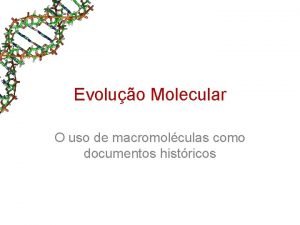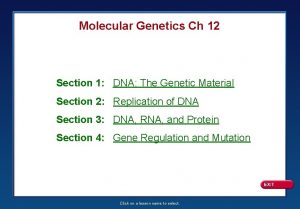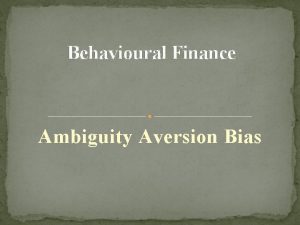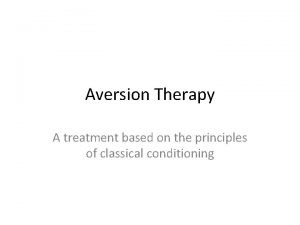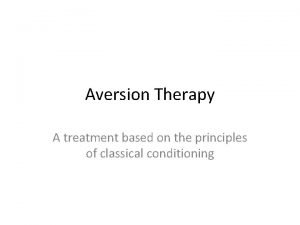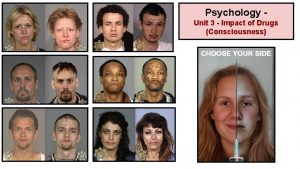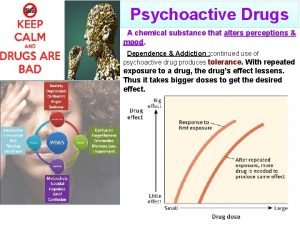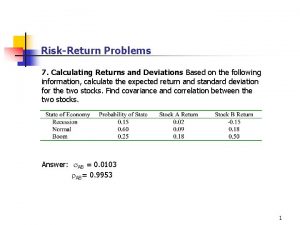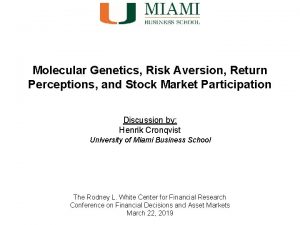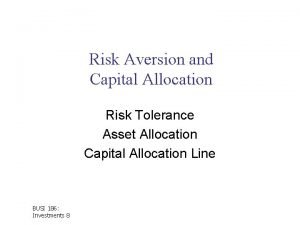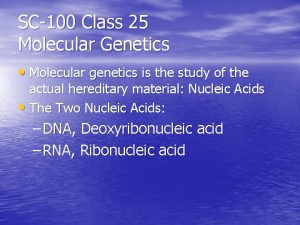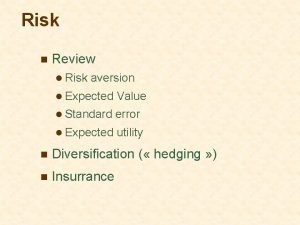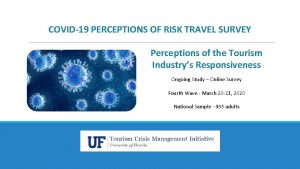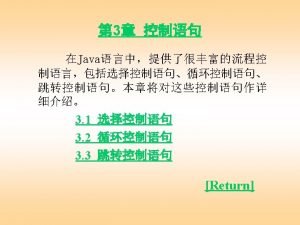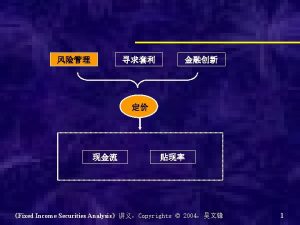Molecular Genetics Risk Aversion Return Perceptions and Stock



























- Slides: 27

Molecular Genetics, Risk Aversion, Return Perceptions, and Stock Market Participation Rick Sias University of Arizona Laura Starks University of Texas Harry Turtle Colorado State University Rodney White Conference on Financial Decisions and Asset Markets March 2019

Motivation – �Do genetic factors impact: �Risk aversion? �Beliefs regarding the distribution of equity returns? �Stock market participation? �Importance of genetic factors �Linking risk aversion and beliefs to stock ownership �Linking other factors (e. g. , wealth, trust) to stock ownership, risk aversion, and beliefs

Molecular genetics �Genome – genetic information needed to build and maintain a human �Contained in 23 pairs of chromosomes within every* cell in your body

Molecular genetics �Each chromosome is one long DNA molecule �Genes are the parts of the DNA that “code” for protein � 99% of DNA is non-coding �“Rungs” of the DNA ladder consist of four nitrogenous bases �A (adenine) �T (thymine) �C (cytosine) �G (guanine)

Molecular genetics �Complementary base pairing (A&T; C&G) �Human genome (i. e. , the 23 chromosomes) have 3. 2 B “rungs” (base pairs)

Molecular genetics �Nucleotide is the side of the ladder + the associated Nitrogenous base (e. g. , highlighted nucleotide is C) �Of 3. 2 B base pairs, <1% vary across individuals which accounts for why we are not identical*

Molecular genetics �Places where two individuals differ are Single Nucleotide Variation � If <1% of population differs, SNV=mutation � If >1% of population differs, Single Nucleotide Polymorphism (SNP) ~10 M SNPs

Molecular genetics �Once human genome mapped, look for relations between SNPs (places where the “rungs” differ) and characteristics -- physical, disease, behavioral �Few characteristics are due to a single (or even few) SNPs �Sickle cell anemia due to a single SNP (Mendelian trait) �Most characteristics are impacted by many SNPs �E. g. , hundreds or thousands of SNPs make

Molecular genetics �Standard approach: Genome Wide Association Studies (GWAS) �Search the entire genome (~all 10 M SNPs in 23 chromosomes) �Because #potential independent variables >>observations regress phenotype on each SNP individually (and controls), e. g. , 10 M regressions �Weight SNPs by effect size to form a single measure known as Poly. Genic Score (PGS)

Data � Health Retirement Study (SSA and National Institute on Aging) � Adults ages 50 -80 � Our sample � Surveys for 2010, 2012, 2014, & 2016 � >6 k individuals and >13 k individual-year observations

Data � � �Genetics �Outcomes Educational Attainment PGS General Cognition PGS Neuroticism PGS Depressive Symptoms PGS � Self-rated risk aversion � Chance market up (>0) � P(RM>20%) Wealth Income Education Cognition �Controls � Gender � Age � HRS Wave � � Myocardial Infarction PGS Coronary Artery Disease PG BMI PGS Height PGS � P(RM<-20%) � Hold any stocks �Traditional explanatory variables � � � � Trust Sociability Optimism Early life poverty � Height � BMI � Health � Retired � Married � Genetic PCs

Genetics, holding stocks, risk aversion, and beliefs � Q 1 - Do genetic endowments help explain variation in risk aversion, beliefs regarding stock returns, and stock market participation? � Regress outcomes on controls and each PGS

Genetics and likelihood of holding any stock

Genetics and beliefs regarding stock returns

Genetics and risk aversion

Genetics, holding stocks, risk aversion, and beliefs � Q 1 - Do genetic endowments help explain variation in risk aversion, beliefs regarding stock returns, and stock market participation? � Yes

Genetics, holding stocks, risk aversion, and beliefs � Q 2 – Can genetics help explain the relation between risk aversion, beliefs, and stock market participation? And, if so, how much? � Step 1: Remove variation in participation, risk aversion, and beliefs related to control variables (e. g. , age, gender, married, retired, HRS waves, & genetic PCs) � “Orthogonalized” participation, risk aversion, beliefs � Step 2: Regress orthogonalized RA (or beliefs) on the eight PGSs � fitted value is “genetic component” � residual is “non-genetic component” � Step 3: Regress orthogonalized participation on genetic

Stock market participation, risk aversion, and beliefs

Stock market participation, risk aversion, and beliefs

Traditional explanatory variables and genetics � Q 2 – Can genetics help explain the relation between risk aversion, beliefs, and stock market participation? And, if so, how much? � Yes � Best estimate: 30% genetic/70% non-genetic

Traditional explanatory variables and genetics � Q 3 a – Can genetics help explain the relation between “traditional” explanatory variables stock market participation, risk aversion, and beliefs? � Step 1: Confirm relation between traditional variables (e. g. , trust) and stock market participation � Higher trust lower risk aversion, more bullish beliefs, and greater equity market participation � Step 2: Test if genetics help explain variation in traditional variables

Genetics and trust

Traditional explanatory variables and genetics � Q 3 b – How much of the relation between outcomes and traditional variables is due to genetic variation in traditional variable versus non-genetic variation? � Step 1: Remove variation in outcomes and traditional variables attributed to the control variables: “Orthogonalized” participation, risk aversion, beliefs, trust � Step 2: Regress orthogonalized trust on the eight PGSs � fitted value is “genetic component” � residual is “non-genetic component”

Genetics and trust

Traditional explanatory variables and genetics � Q 3 – Can genetics help explain the relation between “traditional” explanatory variables stock market participation, risk aversion, and beliefs? And if so, how much? � Yes � Across 11 variables ~ 40% genetic/60% non-genetic

Summing up… • Genetic endowments associated with cognition, personality, health and body shape help explain variation in: • • • Risk aversion Beliefs re the distribution of stock returns Owning stock • About 30% of the relation between stock ownership and risk aversion and beliefs arises from the portion of risk aversion and beliefs explained by these eight genetic endowments • About 40% of the relation between stock ownership and traditional explanatory variables arises from the “genetic”

Thank You!
 Risk aversion indifference curve
Risk aversion indifference curve Parent genotype
Parent genotype Endowment effect and loss aversion
Endowment effect and loss aversion Liquidity measures
Liquidity measures Section 14-3 human molecular genetics answers
Section 14-3 human molecular genetics answers Chapter 12 section 1 dna the genetic material
Chapter 12 section 1 dna the genetic material Chapter 12 section 1 dna the genetic material
Chapter 12 section 1 dna the genetic material Molecular evolutionary genetics analysis download
Molecular evolutionary genetics analysis download Golg11
Golg11 Chapter 12 section 1 dna the genetic material
Chapter 12 section 1 dna the genetic material Chapter 12 section 1 the genetic material
Chapter 12 section 1 the genetic material Behaviorism ap psychology example
Behaviorism ap psychology example Inequality aversion
Inequality aversion Pavlov types of conditioning
Pavlov types of conditioning Pavlov dogs
Pavlov dogs Ambiguity aversion bias
Ambiguity aversion bias Aversion therapy alcohol
Aversion therapy alcohol Aversion therapy evaluation
Aversion therapy evaluation Drugs that alter moods, thoughts, and sense perceptions
Drugs that alter moods, thoughts, and sense perceptions Drugs that alter moods thoughts and sense perceptions
Drugs that alter moods thoughts and sense perceptions Psychedelic drugs that distort perceptions and evoke
Psychedelic drugs that distort perceptions and evoke A chemical substance that alters perceptions and moods
A chemical substance that alters perceptions and moods Melting and boiling point of oxygen
Melting and boiling point of oxygen Ionic covalent metallic
Ionic covalent metallic Zinc oxide + nitric acid → zinc nitrate + water
Zinc oxide + nitric acid → zinc nitrate + water Long-term debt preferred stock and common stock
Long-term debt preferred stock and common stock Common stock characteristics
Common stock characteristics What is the expected return on this stock?
What is the expected return on this stock?








